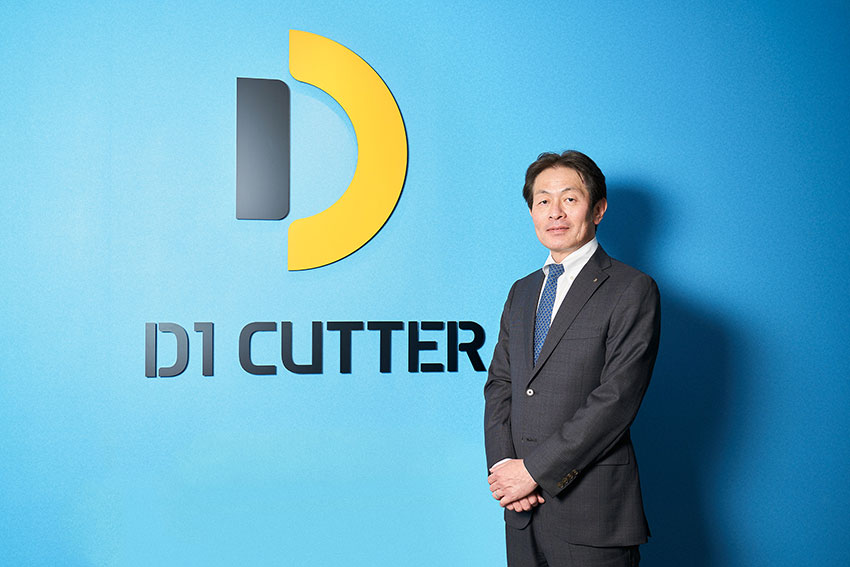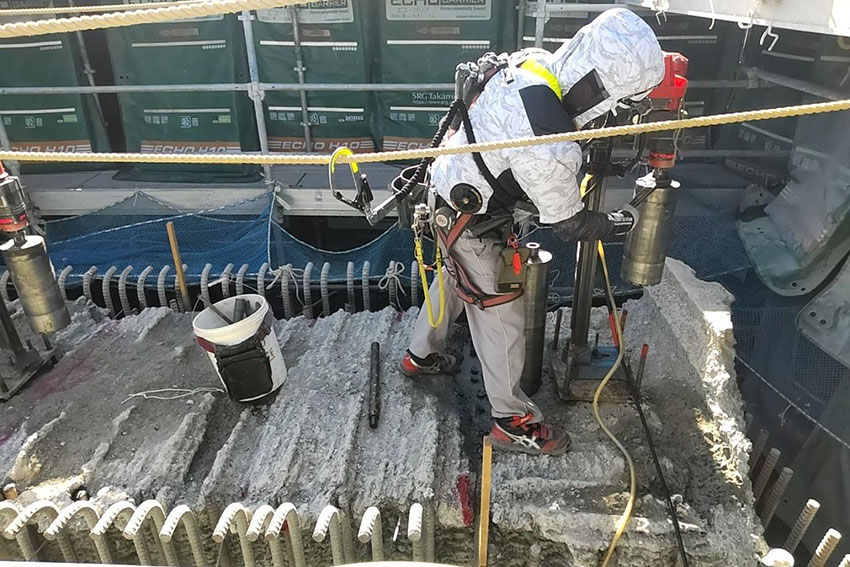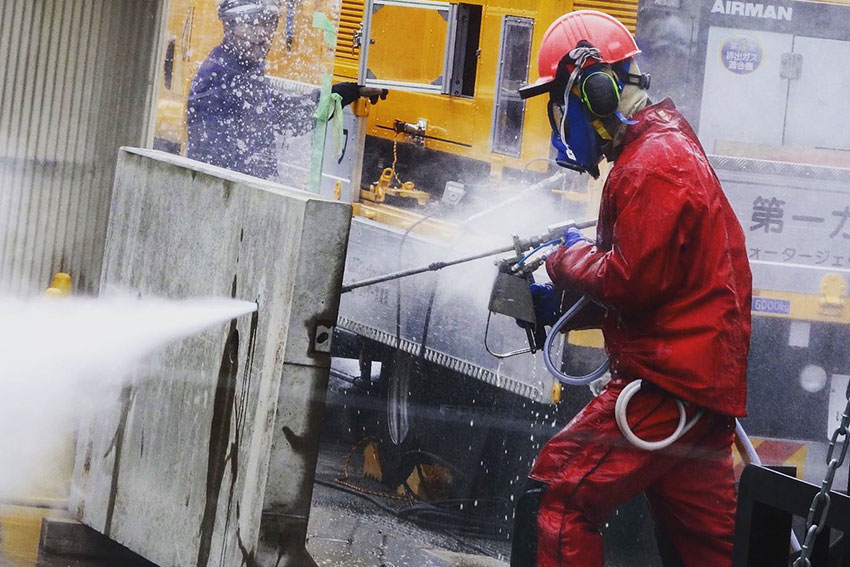Daiichi Cutter introduced flat saws for roads for the first time in Japan and today has developed other methods such as their diamond method to efficiently repair and revitalize infrastructure

Can you give us your take on Japan's current construction needs, and how your company is helping to resolve these issues that are taking place here in Japan?
First, I'd like to premise my comments by saying that within the construction industry, we are in a position where we receive orders from larger construction companies and do our business on that tier.
We can say that since 2010, the 10 years following that, there was huge momentum for big new projects within the construction industry, compared to the years previous to that, because it was decided that the Olympics would be held in Tokyo in 2020.
Also, there was the need for newer construction as a result of having to rebuild after the 2011 Tohoku earthquake.
Not only new projects, but repair and maintenance demands increased as soon as it was decided that the Olympics would be held in Tokyo. That was decided in 2013, and since then, they’ve started to have rising demand, and the need to repair certain highways and bridges to welcome international visitors into the country.
Actually, with regards to tunnel repair, there was an accident related to a tunnel caving in, and it was subsequently decided that ¥3 trillion would be invested into doing tunnel repair work, managed by Nexco as a three-year project.
Since the first construction boom in 1964, there has been a trend in the past 50 years of various infrastructure aging, and as a result of that, various repair needs come about, such as in the water pipelines that have been laid out. 670,000 kilometers of water pipelines have been laid out, and most of them are over 40 years old.
In all parts of the country, even today, we're dealing with situations where certain of these water pipes burst and are causing issues. We haven't been able to catch up to the need for repairing these water pipelines. In reality, only 5100 kilometers of pipelines can be repaired per year.
Within the infrastructure and repair space, the two most pressing needs are to find a way to ensure that the infrastructure is responsive and earthquake resistant. Considering forecasts that at some point soon, there will be a large earthquake coming from the Southern Sea area, and it would hit metropolitan areas, we need to make sure that the infrastructure is earthquake resistant as much as possible, and we must also ensure consistent upkeep to address the aging of the infrastructure. These are the two challenges faced.

Could you tell us the anti-seismic solutions you're able to use to help your clients?
In terms of synergies, earthquake response, or repair maintenance, there are all of these various moving parts involved, and overlapping, and we believe that we can play one important part. For example, we can provide certain technologies that are very crucial in fortifying infrastructure.
Let's say we have a concrete bridge and there's a need to fortify one of the pillars to strengthen the bridge where a steel plate is wrapped around it. We have the kind of technology where we can provide the bolts in a way that provides anti-corrosive properties.
When there's a need to drill a hole in the most accurate and precise method, to do that kind of work, our diamond cutting technologies, or our water jet processes, play a huge role in being able to drill the most precise hole.
Depending on who's providing the orders or who's manning it, depending on the angle of the contractor or the constructor, the needs and priorities might change, and we can cater to all of those different needs and priorities accordingly.
For example, if something is aged and weak, and there is a requirement to peel the concrete and provide a new coating over the concrete and provide new adhesive, to do so, the surface must be more bumpy and rough because that enhances the adhesive qualities. We have that kind of ability to cater to needs in this way.
An easy example is when we consider the drills used by dentists. Dentists utilize drills in a specific way where they only peel off the areas that are the most painful, but they keep as much as possible of the enamel. We can provide such very, very accurate and precise methods, where we only need to deal with the areas that need fixing.
Just returning to your question, I believe that the need for new projects is on the decline here in Japan, especially with the decline of the population. However, there will be a concentration, and the density of new projects will probably be concentrated in certain areas. Because the taxpaying population is on the decline as well, there will be areas where there are more concentrated pockets for investment.
Even among all the construction investments allotted for that, I think maintenance and repair will take on the majority. I think moving forward in the long term, the strategy that Japan is taking is to ensure the longevity of the infrastructure in place and to look at how to lengthen the life cycle of the infrastructure. I think it's a strategy of preventative repair, really being able to conduct the required maintenance and repair before it's too late.
You mentioned that with the declining population, there will be fewer taxpayers. Of course, your work is very labor intensive, so you also need a lot of specialized workers to conduct this work. We know the construction sector has one in four people over the age of 65. There's a real need to attract younger people to the business. As the president of a company, how are you adapting to these population changes? What steps are you taking to ensure the longevity of your business in terms of labor?
What we are doing is enhancing our promotion and recruitment tools by utilizing social media, rebranding our company to make it more attractive to younger recruits, and enhancing our visibility by increasing meetings and points of interaction with younger students. We changed our uniform as well, to make it trendier.
We're also looking to see how we can actually ensure a low turnover of staff, and instead enable those who, once they join, feel like they want to continue working at the company. We make sure that we can provide services for all of their family members, such as enabling all the family members to take regular medical checkups, providing certain monetary incentives when their children are born, and giving them monetary gifts of over ¥100,000 per child. Even providing support for fertility treatment as well, when necessary.
We've been putting a lot of effort into enhancing the work-life balance in our company. The average age of our staff at the moment is 38.5 years of age, so we're putting a lot of effort into being able to maintain a younger average age of employees.
Even then, you can't stop the huge momentum of the fact that one in four within the industry are 65 plus, so we're putting different measures into place to ensure that our company will always be known as a resource for young and thriving workers.

The founder of Daiichi first introduced the flat saw for road cutting here in Japan, and of course, today you have your unique diamond cutting method, which is very precise and very clean. It also reduces noise. And of course, your water jet tool, which can destroy concrete bonds. It’s very strong. You were listed in 2014, for the first time, and you graduated to the prime level of the Tokyo Stock Exchange in 2017. Could you give us an insight into why you've become this premier company when it comes to cutting? What is your unique selling point?
We started our business using our technology for road cutting, and I believe that we were able to continue to grow with the rising need for sewage pipelines and sewage systems, and that kind of infrastructure, within Japan.
In Japan, the foremost importance was placed on creating hygienic and sanitary infrastructure. From that perspective, a lot of investment was put into ensuring that we had a very, very premier and cutting-edge underground sewage system.
Japan is very limited when it comes to geography. Being a small country, they've had to consolidate and make the most efficient use of its underground systems. Underground, the primary layer is an organized sewage system, but apart from that, we need to ensure the other utilities’ lines, like water and gas. All of those lines also need to be consolidated underground. To lay down the sewage system, they had to cut the road five times.
You could say that we have finally achieved 90% penetration in laying down the sewage pipes for the sewage system. When we started the company, our major contracts were with road cutting, and with the need for the road to be cut in various locations, we grew as a company in the sense that we needed to open up in different locations across Japan as a result of needing to conduct road cutting for expanding the sewage system, and the need for more people to conduct that work of social infrastructure, that's how our company grew, and how we have all of these different offices throughout Japan now.
With that as the base, we had already gained a certain level of recognition within the industry for our road cutting, and when we expanded our portfolio of products and services to include other technologies such as the water jet process and others, slowly we were able to continue to penetrate in terms of being known within the industry because we already had this base.
You're repairing roads which are used daily by drivers of cars. When repair takes place, there’s a need for diverting the traffic or doing it at night time, and to that end, we saw that you invented the Hydro-Jet RD method, which cuts repair times by more than 50%. You did so in collaboration with Hanshin Expressway and Tobishima. Could you tell us a little bit more about that technology, and similar technologies that are reducing the amount of time needed for these repairs?
First, I'd like to say that we've grown, as a company, as a result of our focus on how to resolve the issues and challenges that our clients brought to us. For example, even with our work for Tobishima, the homework that they gave us was to find a way to remove concrete within a five-centimeter depth, and now their homework is to make it to two centimeters. We believe that that's been the secret to our growth. Being able to provide solutions to the kind of challenges brought to us by our clients.
Another huge and challenging project that we've been given, is to support the nuclear waste removal in the Fukushima Daiichi nuclear power plant, the famous one that you remember from the earthquake. Such challenging projects, involving dealing with nuclear waste and things like that, are something that we pride ourselves on being able to do. We receive orders from Atox as well.
You work closely with clients like Tobishima, but we also know you've engaged in a series of M&As recently. You acquired Acile and Unipec, more recently. Can you tell us the benefits these new company acquisitions bring to your group, and are you interested in acquiring more companies, perhaps, from overseas locations?
We base ourselves in the civil engineering field, and we’re looking to strengthen our position there. We're looking to see how we can partner with those who may have expertise in other fields.
For example, Acile is the newest partnership. They have expertise when it comes to renovation projects and architecture. We look to see how we can work with various companies to cover areas that may not necessarily be our strength. In this way, we can increase our overall strength.
The rationale behind partnering with Unipec was that their expertise is in refinery and chemicals, and so we hoped that we could leverage their strengths, connecting them with our strengths, which are in electrical power plants. We could support them through that connection and provide this interesting win-win synergy situation.
Our approach to overseas partnerships is the same as our approach to domestic partnerships, which is that we're looking for technological tie-ups where we can leverage each other’s strengths. We are looking to see what kind of technological strengths they may have, how that can benefit us, and how we could benefit them on that level.
However, we believe that before actually entering into a partnership, it's important to have exchange and interaction with potential partners, especially when it comes to, for example, North America, where they’re quite strong when it comes to nuclear energy. We’re seeing how we can increase the points of exchange with such types of potential partnerships.
Could you tell us a little bit more about the digital tools you're using in your day-to-day work, and how you are helping to streamline your operations using them?
From the administrative side, how we've been incorporating digital tools is, as you've already probably gathered from being here in Japan for many years, the Japanese are weak when it comes to communication. They're not the strongest communicators, so we've been implementing digital tools to enhance communication. DX tools are something that we've been implementing internally. Up until now, invoices were all paper-based, but we've made them paperless.
When it comes to how we're utilizing digital technologies in our construction methodologies and on-site, oftentimes it's very difficult to standardize the work we do because it's based on each site, and the tools and processes required are site-specific, so it's very difficult to automate in one universal, standardized way.
However, we are looking to see how we can, first of all, gather the data and information to begin to better ascertain the information that can be utilized for skill transference. Right now, how we're accumulating data related to the needs of laborers, and how we can begin to transfer that skill set. We're right now gathering biometrics from the laborers such as what is the kind of eyesight required, or the level of strength they need. The stress points. Utilizing GPS to see how they move, and things like that.
You first expanded overseas when you went to Indonesia in 2005 with an ODA project, and you've since worked in Kuwait, Nigeria, and Vietnam. Firstly, could you tell us what is the biggest lesson you've learned so far from those projects, secondly, moving into the future, which new countries or regions do you see as having the most potential for your business?
The biggest lesson we've learned is that when it comes to construction, the approach of the Japanese versus the Europeans, or those from the West, is the basic cost of things. There's a certain level that Japan needs in terms of the minimum cost, and that doesn't exist when it comes to the West. It can go as low as they want it to be.
I think the Japanese construction industry as a whole has been able to benefit from not having to think of how low they can take costs, because they've been able to have a set cost mentality, and it’s not a race to the bottom.
I believe that is the biggest reason why they're not able to compete when it comes to projects overseas. That was a big lesson we learned when we started to conduct projects abroad. That was something we also learned when we were involved in projects working on US military bases. I guess that's the biggest lesson.
When it comes to interesting areas abroad that we would want to expand into or conduct projects in, it's those areas that value such unique technologies within construction projects, such as our diamond cutting method, or water jet method and are interested in utilizing such assets.
I also believe it's important that if there are people we work in areas where the people are quite strict when it comes to reducing noise pollution and trying to make construction as eco-friendly as possible.
Also, areas that are prone to earthquakes. From that perspective, areas of interest are the Asian region, in particular Thailand and Indonesia. Even when it comes to the ODA projects that Japan has undertaken in such countries, those bridges and tunnels are also getting old, so I think in a few years they will need repair and there will be an opportunity for us.
Let's say we come back to interview you again in four years for your company’s 60th anniversary. What would you like to tell us about your goals and dreams for the company in that timeframe, and what would you like to have achieved by then?
Four years from now, I would love to be able to share with you actual proof of these projects taking off overseas. We are often bound by contractual obligations that make it difficult for us to share the kind of work that we've done, and been involved in, but I do believe that four years from now, it would be such an honor to be able to tell international media about the kind of projects that we have been able to participate in, with pride. I'm sure we will have been doing some excellent work.
0 COMMENTS